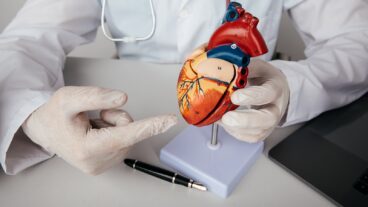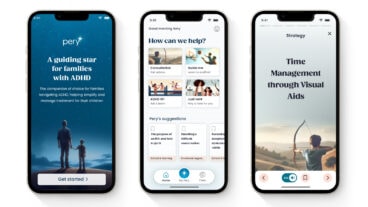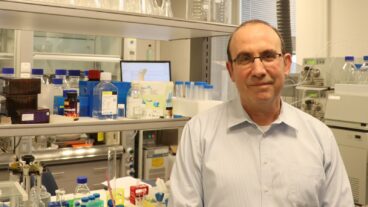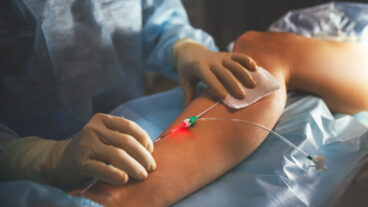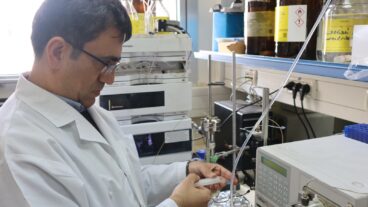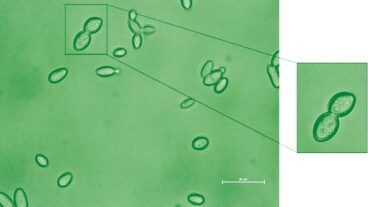Liver biopsies are an invasive, uncomfortable and painful ordeal. A long hollow needle is pressed into the abdomen to remove tissue samples to assess liver injury resulting from infectious disease like Hepatitis C, or metabolic liver diseases related to overweight and obesity.
But thanks to an Israeli innovation called BreathID, a patient now merely has to breathe into an instrument and wait 20-30 minutes to determine the status of his liver, its function and whether he should be prescribed treatment. The device, which has been tested on over 300 Hepatitis C and NAFLD (Non-Alcoholic Fatty Liver Disease) patients, will enable physicians throughout the world to enlarge the scope of diagnosing and treatment of liver diseases
Hepatitis C (HVC) is the most prevalent blood-born disease in the world. The World Health Organization considers Hepatitis C an epidemic. It is often called the “silent” epidemic because it can infect a patient for decades before being discovered. Approximately 4 million people in the US are chronically infected with the Hepatitis C virus. Between 10,000 and 12,000 people die of Hepatitis C annually in the US, and 73,000 are newly infected each year. NAFLD affects about 20% of the western world adult population and like obesity, the cause for this disease, it is a great concern of the medical community worldwide.
The BreathID diagnostic and disease management device was developed by Oridion Systems Ltd., but its rights were recently acquired by Hadasit, the technology transfer company of the Hadassah Medical Organization and scientist/entrepreneur Dr. Uri Geiger.
“It’s a totally new concept in liver testing,” says Geiger, who manage BreathID. “Right now, the only alternative is a blood test, which is not a very efficient or accurate tool to assess the condition of the liver. Until now, the most accurate way remains a liver biopsy – which is not only invasive, but expensive, and potentially dangerous – one in 10,000 people die from it,” he told ISRAEL21c.
A liver biopsy is often used to diagnose the condition of the liver and status of liver disease. It is also used to diagnose liver tumors identified by imaging tests. In many cases the specific cause of the chronic liver disease is highly suspected on the basis of blood tests, but a liver biopsy is used to determine the amount of damage to the liver.
With its non-invasive approach, and accurate and speed results, the BreathID will replace the need for many of the liver biopsies being performed today, says Geiger, a business veteran who joined Oridion in 2005 and led the development of BreathID.
Liver function breath testing is based on monitoring the liver’s metabolism of a specific c13 marked substrate. The by-product of this metabolism is 13CO2, which alters the 13CO2/ 12CO2 isotope ratio in exhaled breath
“The patient is connected to the BreathID device via a nasal cannula and a baseline breath is measured.,” he explained. Then the patient drinks a substrate marked by c13 molecules – it gives a known dose of c13 to a patient and it’s directed to a specific organ – in this case the liver. The device continues measuring the exhaled breath for half an hour, and automatically measures changes in the 13C/C02 ratio due to metabolization.
“The c13 starts metabolizing in a matter of a few minutes. If a person is healthy, there’s a nice steady curve reflecting good metabolism. It’s then compared to the gold standard in liver testing – the liver biopsy – every study we do includes liver biopsies for comparison.,” said Geiger.
The BreathID uses Oridion’s prime technology, which is based on capnography – the non-invasive measurement of carbon dioxide in exhaled breath, Oridion’s monitoring devices are recognized world-wide as the single most effective technology for monitoring breathing in patients and used by companies like Phillips, Siemens, Tyco, Medtronic and others.
Capnography is important to both physicians and patients. Twenty years ago, many patients died in operating rooms because they did not wake up from anesthesia even if the operation was successful. Today, a negligible number of deaths are due to these complications, as capnography has become a standard of care in the operating room. Capnography is also essential to care-providers in environments such as procedural sedation, intensive care, emergency care, respiratory care settings, and outpatient clinics.
Oridion worked on this core technology to develop the breath test, but they failed to bring the product to market, explained Geiger.
“The area they chose to focus on was the detection of the Helicobacter pylori bacteria in the stomach – the cause of peptic ulcers and stomach cancer. But there are other means to detect the bacteria, and despite having invested a lot of time and money in the FDA process, and commercializing the device in the US, they failed in their attempts,” said Geiger.
“Together with Hadasit, I purchased the assets and the technology – the IP, inventory – and incorporated it into BreathID.”
Geiger, with a PhD from Columbia, has already successfully sold two companies, after working for years on Wall Street. He also teaches finance at Tel Aviv University’s school of business and has published a number of books on venture capital.
“When the problems started with Oridion, they asked me to step in, and I acquired an equity position – together with our main clinical chief, Professor Prof. Yaron Ilan, shifted the focus to liver application,” said Geiger.
Leaders of the American Liver Society supported Hadasit’s purchase and the creation of the new company – effective last month – and are participating as members of the Breath ID scientific advisory board.
“I consider Hadasit’s entry into technological and financial activities an integral part of our commitment to improving medicine,” said Hadasit CEO Dr. Rafi Hofstein. “The establishment of Breath ID will allow us to advance the progress of diagnosing infectious liver diseases and may even reveal new ways of treating these diseases.”
He emphasized the importance that Ilan – the chairman of the Israel Association for the Study of the Liver – had played in shifting the focus of the device to liver diagnosis.
“Yaron Ilan has been in touch with the people at Oridion for 10 years. And even while they were developing the BreathID for the GI tract, he was suggesting it would be better targeted for liver malfunction and disease,” said Hofstein.
“After it failed to take off, Oridion, which is publicly traded in Switzerland, decided to consolidate assets last years and spin off BreathID. Geiger stepped back and looked at the options, and decided to revisit the discussion with Yaron. And the rest is history,” Hofstein told ISRAEL21c.
“Yaron is a firm believer in this approach, he’s a very prominent physician and scientist at Hadassah, and he basically persuaded us to make a financial investment in BreathID – which is an exception to the rule. Usually, we bring the IP to the table and have others make the investment. But we felt that BreathID is going to be a lucrative investment for all practical purposes.”
Geiger calls the relationship with Hadassah “very tight” and many of the 300 clinical trials performed in Israel took place at the Hadassah Medical Center. Other trial took place in Rabin Medical Center and in Europe.
“The results are very encouraging,” said Geiger, adding that BreathID’s first American trials will begin later this month at Mount Sinai in New York, Baylor University in Houston and VCU in Richmond.
Geiger has begun the process for FDA approval, and he estimates that BreathID will be used in American medical centers and clinics in 2007. Hadasit’s Hofstein is equally optimistic.
“The company is now pushing full force ahead in the direction of the liver diagnosis. Once we’ve perfected the Hepatitis C diagnosis, we’ll move on to everything else. The assumption is that once it’s proven as a concept, the machine will be able to be used of all kinds of liver dysfunctions.”




